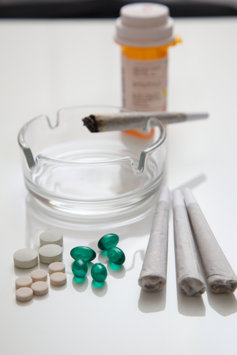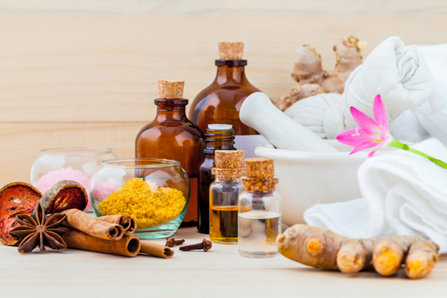Is There a Connection Between Marijuana Use and Prescription Drug Use?

People seek drugs for all kinds of reasons. Some are trying to find an escape from a struggle or difficulty that they are facing in life. Others are peer pressured by their “friends” into using drugs. Some want to experience something different, something that makes them feel good. Others want to forget a loss or painful hardship.
Each individual will have his or her own, personal reasons for turning to drugs. The underlying reasons will likely be unique to each person. But even though each person has his or her own reasons and underlying struggles, we are always seeking to understand the overall, primary incentives to try drugs. In light of the prescription opioid boom of the late-1990s and into the 2000s, we have come to realize that people often seek drugs to reduce pain. It’s not the only reason people turn to certain drugs, but it’s definitely one of the main ones.
A Study of the Connection Between Marijuana Use and Prescription Drug Use
A 2017 publication in the National Institute on Drug Abuse reported a growing concern regarding marijuana use and prescription opioid misuse. The NIDA publication was actually able to draw a correlation between marijuana use and prescription opioid use. The study suggested that people who use marijuana are more likely to use prescription opioids. Such a correlation flies in the face of some theories which suggest that people who use marijuana are more likely to avoid using prescription opioids.
The NIDA publication can neither prove nor deny anything. More research is definitely needed. However, it’s worth our while to examine the research and arrive at our own conclusions about it.
According to the NIDA publication, “The analysis indicated that respondents who reported past-year marijuana use in their initial interview had 2.2 times higher odds than nonusers of meeting criteria for prescription opioid use disorder by the follow-up. They also had 2.6 times greater odds of initiating prescription opioid misuse, defined as using a drug without a prescription, in higher doses, for longer periods, or for other reasons than prescribed.”
“These findings are in-line with previous research demonstrating that people who use marijuana are more likely than non-users to use other drugs and develop problems with drug use.”
The researchers stated: “These findings are in-line with previous research demonstrating that people who use marijuana are more likely than non-users to use other drugs and develop problems with drug use.”
At the same time, the research also recognizes that some studies have come forth suggesting that states which legalize marijuana may see reductions in prescription opioid misuse, as residents of those states now have a legal alternative to opioid pain relievers.
Again, more research is needed. But one thing we can be sure of is this. Wouldn’t it be better if those who sought pain relief could find remedies for pain that did not include either cannabis or opioids?
What Can We Do for Pain, Instead?

Ideally, we would find a way to reduce both prescription drug use and marijuana use. To accomplish that, we should address one of the key reasons why so many people turn to these drugs, in the first place. That reason is physical pain.
Though alternative and holistic pain remedies do not receive much attention in the public light, there are legitimate and effective means for reducing pain symptoms without turning to potentially addictive drugs.
One could comment on the strange, almost unnatural degree of support for both marijuana and opioid pills for pain relief. One side of the population seems to support a pharmaceutical route. The other prefers a cannabis route. What about a third option? What about an alternative that accomplishes pain relief without harmful side effects?
Let’s explore a few of the alternatives in pain relief that do not possess habit-forming risks:
- Chiropractic Care. Much of what pains people can be traced to misalignments of the spine which can be corrected with chiropractic care. Rather than taking pain drugs or marijuana for a “bad back,” it’s possible that a monthly visit to a chiropractor’s office would suffice. Furthermore, chiropractic care resolves the cause of the problem (misalignment of the spine) whereas drugs seek only to mask the symptoms.
- Willow bark. A holistic medicine that has been in use since Ancient Greek times, willow bark is a simple, natural method of relieving pain. According to MedlinePlus, “Willow bark acts a lot like aspirin, so it is used for pain, including headache, muscle or joint pain, menstrual cramps, rheumatoid arthritis (RA), osteoarthritis, gout, and a disease of the spine called ankylosing spondylitis.”
- SAM-e Supplements. An article from the Arthritis Foundation talks about the benefits of natural supplements and alternatives to painkillers for addressing pain symptoms. Perhaps most significant of these alternatives is SAM-e supplements. SAM-e is a chemical compound naturally produced within the body. It is a chemical compound with its own anti-inflammatory properties. Taking supplements of this compound serves to boost the body’s own ability to counteract pain.
- Turmeric/Curcumin. The Arthritis Foundation article also talks about turmeric and curcumin, citing this simple, easy-to-find spice as having significant, pain-relieving properties. According to the report, “Curcumin is the chemical in turmeric that can reduce joint pain and swelling by blocking inflammatory cytokines and enzymes. A 2010 clinical trial using a turmeric supplement showed long-term improvement in pain and function in patients with knee OA (osteoarthritis).”
Briefly summated, there are two, key goals when seeking a non-pharmaceutical and non-cannabis based approach to physical pain. First off, it’s important to find the source of the pain, i.e., what in the person’s body is causing them to experience that pain. Secondly, it’s important to treat that source by various holistic means so as to still offer the person real pain relief but to do so without using risky or hazardous drugs like opioid painkillers or cannabis drugs.
What to Do When Someone is Already Dependent on Drugs
Alternative pain relievers are workable remedies for getting adequate pain relief without turning to drugs such as marijuana or opioid pharmaceuticals. But what about if someone is already taking these drugs and is hooked on them? At this point, the person’s physical pain is no longer the primary concern. At this point, the drug-using habit has taken over and must be addressed.
If you or someone you know is using marijuana or prescription opioids and is having a difficult time getting off of them, the correct solution is to get the person help through a residential drug and alcohol addiction treatment center. Residential drug rehabs offer the safest, most effective route for breaking free from an addiction habit, no matter how crippling or harsh that addiction habit is. If you know someone who needs help, do your best to assist them in finding a treatment center as soon as possible.
Sources:
- https://www.drugabuse.gov/news-events/news-releases/2017/09/marijuana-use-associated-increased-risk-prescription-opioid-misuse-use-disorders
- https://www.health.harvard.edu/pain/chiropractic-care-for-pain-relief
- https://medlineplus.gov/druginfo/natural/955.html
- https://www.arthritis.org/living-with-arthritis/treatments/natural/supplements-herbs/9-supplements-arthritis.php
Reviewed and Edited by Claire Pinelli, ICAADC, CCS, LADC, MCAP, RAS


 ®
®